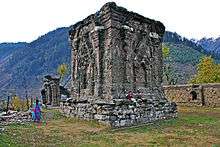Multan Fort
The Multan Fort, a military installation, was a landmark of South Asian defence and architecture. According to some estimates the original fort was built between 800 and 1000 B.C. It was built near the city of Multan by the Katoch dynasty, in Punjab province, on a hillock separated from the city by the Ravi River. The fort was destroyed by British forces during the British occupation of India.
The fort was notable for both its effectiveness as a defence installation and for its architecture. Contemporary reports put the walls of the fort at 40 to 70 feet (21 m) high and 6,800 feet (2 km) in circumference. The fort's 46 bastions included two flanking towers at each of the four gates (the De, Sikki, Hareri and Khizri Gates). A ditch 25 feet (7.6 m) deep and 40 feet (12 m) wide and an 18-foot (5.5 m) glacis protected the fort from intruders.
Within the fort stood a citadel flanked by 30 towers, enclosing mosques, a Hindu temple and a Khan's palace. The citadel was severely damaged by the battering it got from the guns of Maharaja Ranjit Singh in 1818.
The Fort was originally known as Katochgarh and is attributed to have been built by the Katoch Dynasty. Coordinates: 30°11′56″N 71°28′24″E / 30.19889°N 71.47333°E
Hindu temple
The Prahladapuri temple like the Sun Temple of Multan had been destroyed after Muslim conquest of Multan, suffered several material losses and was reduced to a nondescript shrine by the 19th century. It is located on top of a raised platform inside the Fort of Multan, adjacent to tomb of Hazrat Baha’ul Haq Zakariya.[1] A mosque has subsequently built adjacent to temple.[2] In 1992, the temple was completely destroyed by a violent Muslim mob, claiming retaliation for the partial destruction of Babri Masjid built on birth place of Lord Ram in Ayodhya, India by a mob.[3] The temple is in ruins since its destruction by violent Muslim mob in 1992. In 2006, on occasion of Urs of Baha-ud-din Zakariya, the minister of government, ordered construction of facilities for Wuzu and in 2008 facilities for Langar in premises of temple. These actions were later protested by some NGOs as according to the Constitution of Pakistan, no Muslim construction can be done within the places of worship of other religions. A case was filed and court ordered stay on construction. The matter is still pending in court. Many peaceful protests were held by minority organizations and many persons and organizations have requested Government of Pakistan to restore this ancient temple of importance.[3]
Gates
There were four other gates which belong to Kohna Fort of Multan, out of which only first survives.
Qasim Gate
Khizri Gate
Sikhi Gate
Hareri Gate
See also
References
- ↑ "Archived copy". Archived from the original on 2015-01-07. Retrieved 2015-01-07. Survey & Studies for Conservation of Historical Monuments of Multan. Department of Archeology & Museums, Ministry of Culture, Government of Pakistan
- ↑ Muslim Saints of South Asia: The Eleventh to Fifteenth Centuries By Anna Suvorova. p. 153.
- 1 2
